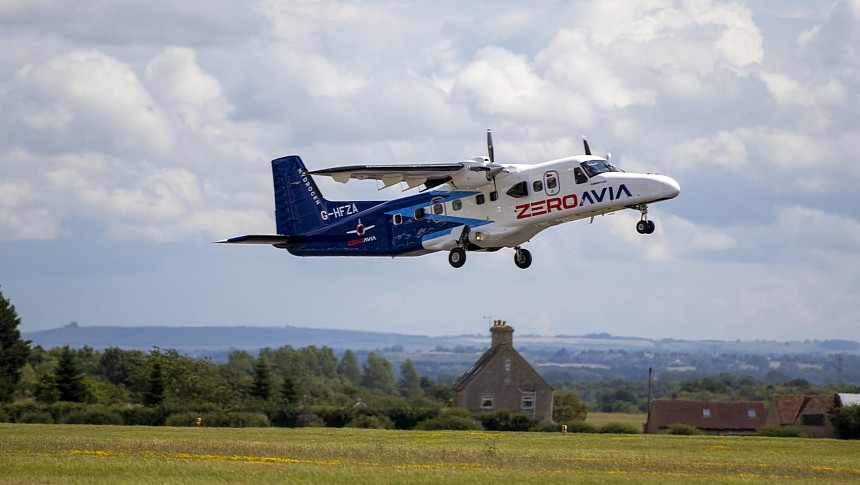ZA600 is the name of a hydrogen-electric powertrain that could change commercial airline operations forever. ZeroAvia, the trailblazing company that developed this aircraft powertrain, recently ended a complex flight test campaign using a retrofitted Dornier 228. The ZA600 proved its efficiency and reliability all the way through ten flights in various challenging conditions.
In the summer of 2021, ZeroAvia kicked off ground testing of its proprietary hydrogen-electric powertrain, the 600 kW ZA600. A large mobile ground testing platform was used to carry out these initial tests at ZeroAvia's headquarters in Hollister, California.
The hydrogen aviation company is based in the UK and the US, so it worked on parallel projects using two different Dornier 228 aircraft. ZeroAvia's bold vision is that existing airliners could be retrofitted with its hydrogen-electric propulsion systems, with the goal of advancing zero-emission commercial flights.
The ZA600 was designed for regional airliners with nine to 19 seats, targeting a moderate 300-mile (482 km) range. ZA2000 is the company's 2MW+ powertrain, specifically developed for 40-80 seat aircraft and a range of more than 700 miles (1,126 km).
Over the past years, ZeroAvia has conducted multiple flight tests after obtaining experimental certification for three prototypes in both the UK and the US. Plus, operators worldwide, including major airlines, have already pre-ordered the company's powertrain and retrofitting package, adding up to almost 2,000 engines so far.
This year, it kicked off a complex test flight campaign using a Dornier 228 that was retrofitted with the ZA600. All ten test flights were carried out at the Cotswold Airport. Last week, the retrofitted Dornier broke its own record, reaching an altitude of 5,000 feet (1,524 meters) and flying for approximately 20 minutes.
It was the tenth and final flight in this pioneering campaign. In addition to setting these altitude and endurance records, the ZA600 also had to withstand extreme temperatures, going from above-freezing points to 30C (86F). In terms of speed, the Dornier 228 flew as fast as it was allowed by its CAA-issued Permit to Fly.
According to ZeroAvia, the ZA600 matched the performance of the conventional fuel engine in the opposite wing. During certain tests, the Dornier was able to rely solely on the thrust generated by the ZA600.
Even with the success of this extensive flight test campaign, ZeroAvia still has a long way to go. The first commercial retrofitted regional aircraft could enter service two years from now, while larger airliners equipped with the ZA2000 won't be flying earlier than 2027.
This Dornier 228 test campaign benefitted from government funding as part of the UK's HyFlyer II project through ATI (the Aerospace Technology Institute) and Innovate UK.
ZeroAvia's vision goes far beyond this decade. By 2045, it believes 200-seat airliners could cover 5,700-mile (9,200 km) routes, powered exclusively by hydrogen-electric systems.
The hydrogen aviation company is based in the UK and the US, so it worked on parallel projects using two different Dornier 228 aircraft. ZeroAvia's bold vision is that existing airliners could be retrofitted with its hydrogen-electric propulsion systems, with the goal of advancing zero-emission commercial flights.
The ZA600 was designed for regional airliners with nine to 19 seats, targeting a moderate 300-mile (482 km) range. ZA2000 is the company's 2MW+ powertrain, specifically developed for 40-80 seat aircraft and a range of more than 700 miles (1,126 km).
Over the past years, ZeroAvia has conducted multiple flight tests after obtaining experimental certification for three prototypes in both the UK and the US. Plus, operators worldwide, including major airlines, have already pre-ordered the company's powertrain and retrofitting package, adding up to almost 2,000 engines so far.
This year, it kicked off a complex test flight campaign using a Dornier 228 that was retrofitted with the ZA600. All ten test flights were carried out at the Cotswold Airport. Last week, the retrofitted Dornier broke its own record, reaching an altitude of 5,000 feet (1,524 meters) and flying for approximately 20 minutes.
It was the tenth and final flight in this pioneering campaign. In addition to setting these altitude and endurance records, the ZA600 also had to withstand extreme temperatures, going from above-freezing points to 30C (86F). In terms of speed, the Dornier 228 flew as fast as it was allowed by its CAA-issued Permit to Fly.
According to ZeroAvia, the ZA600 matched the performance of the conventional fuel engine in the opposite wing. During certain tests, the Dornier was able to rely solely on the thrust generated by the ZA600.
Even with the success of this extensive flight test campaign, ZeroAvia still has a long way to go. The first commercial retrofitted regional aircraft could enter service two years from now, while larger airliners equipped with the ZA2000 won't be flying earlier than 2027.
This Dornier 228 test campaign benefitted from government funding as part of the UK's HyFlyer II project through ATI (the Aerospace Technology Institute) and Innovate UK.
ZeroAvia's vision goes far beyond this decade. By 2045, it believes 200-seat airliners could cover 5,700-mile (9,200 km) routes, powered exclusively by hydrogen-electric systems.








